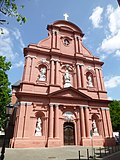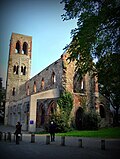Bild
Inneres
Name
Stadtteil / Lage
Bauzeit
Anmerkungen / Baustil
Dom St. Martin
Mainz Standort 11.–13. Jh.
Romanische Bischofskirche
St. Stephan
Mainz Standort 1267–1340
Spätgotische Hallenkirche; Überregionale Bekanntheit verdankt sie der von Marc Chagall gestalteten Kirchenfenster.
St. Emmeran
Mainz Standort 14. Jh.
Spätgotische Kirche mit romanischem Turm
St. Quintin
Mainz Standort 1288–1330
Gotische Hallenkirche mit romanischem Turm
St. Peter
Mainz Standort 1749–1756
Kirche im Stil des Rokoko
St. Ignaz
Mainz Standort 1763–1775
Kirche im Stil des frühen Klassizismus
Augustinerkirche Hl. Dreifaltigkeit
Mainz Standort 1768–1771
Barocke Stiftskirche; heute Kirche des Priesterseminars des Bistums Mainz .
Karmeliterkirche Mariä Himmelfahrt
Mainz Standort 14. Jh.
Gotische Kirche mit spitzem Dachreiter. Seit 1924 Sitz der Karmeliten
Kapuzinerkirche Maria Mater Dolorosa
Mainz Standort 1901
ursprünglich Kapuzinerkirche; heute Mutterhauskirche der Marienschwestern
Klarissenklosterkirche
Mainz Standort ~ 1990
Klarissenklosterkirche (Kapuzinerinnen von der ewigen Anbetung). Der Konvent besteht bereits seit seiner Neugründung im Jahr 1860 dort.
St. Bonifaz
Mainz Standort 1954
Neubau der Kirche nach vollständiger Zerstörung des neugotischen Vorgängerbaus im Zweiten Weltkrieg.
St. Joseph
Mainz Standort 1957
Neubau der Kirche nach vollständiger Zerstörung des neugotischen Vorgängerbaus im Zweiten Weltkrieg.
Liebfrauen
Mainz Standort 1966
St. Georg
Mainz /Bretzenheim Standort 1722
Barocke Saalkirche
St. Bernhard
Mainz /Bretzenheim Standort 1992
In St. Bernhard befindet sich die einzige Orgel von Aristide Cavaillé-Coll auf deutschem Boden.
Maria Königin
Mainz /Drais Standort 1737
Barocke Saalkirche
St. Laurentius
Mainz /Ebersheim Standort 1729/
Barocke Saalkirche
St. Martin
Mainz /Finthen Standort 1863
Neuromanisches Kirchengebäude
St. Hedwig
Mainz /Finthen Standort 1984
St. Stephan
Mainz /Gonsenheim Standort 1906
Aufgrund der stattlichen Größe und repräsentativen Doppelturmfassade in der Umgangssprache auch als Rheinhessendom bezeichnet.
St. Petrus Canisius
Mainz /Gonsenheim Standort 1956
St. Rabanus Maurus
Mainz /Hartenberg Standort 1965
Modernes Kirchengebäude mit weit vorgelagertem Kirchturm.
St. Pankratius
Mainz /Hechtsheim Standort 1752
Barocke Saalkirche mit neugotischer Erweiterung
Mariä Heimsuchung
Mainz /Laubenheim Standort 1720/
Barocke Saalkirche mit neubarocker Erweiterung im Jahr 1908
St. Franziskus
Mainz /Lerchenberg Standort 1984
St. Stephan
Mainz /Marienborn Standort 1730
Barocke Saalkirche
Herz Jesu
Mainz /Mombach Standort 1913
Neugotische Pfarrkirche von Architekt Ludwig Becker .
St. Nikolaus
Mainz /Mombach Standort 1956
St. Johannes Evangelist
Mainz /Münchfeld Standort 1968
St. Albertus
Mainz /Münchfeld Standort 1961
Katholische Hochschulgemeinde
St. Rochus
Mainz /Oberstadt Standort 1914
Katholische Klinikpfarrei
St. Alban
Mainz /Oberstadt Standort 1952
Heilig Kreuz
Mainz /Oberstadt Standort 1954
Fächerförmiges Kirchengebäude mit Kuppel im Zentrum
St. Jakobus
Mainz /Oberstadt Standort 1982
Mariä Himmelfahrt
Mainz /Weisenau Standort 1913
Pfarrkirche von Architekt Ludwig Becker .
St. Achatius
Mainz /Zahlbach Standort 1810
Klassizistische Saalkirche
































































